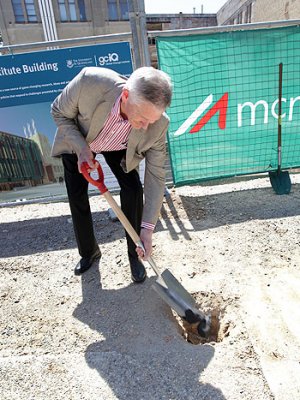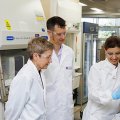
University of Queensland alumnus and visionary philanthropist Graeme Wood has marked the beginning of construction of UQ’s new Global Change Institute Living Building with a symbolic gesture of carbon sequestration.
Mr Wood was joined on November 21 by members of the senior executive, GCI Director Professor Ove Hoegh-Guldberg and members of the design and construction companies in burying a piece of coal under the foundations of the new building.
Mr Wood generously donated $15 million towards the construction of the $30 million building, which is designed to be carbon neutral and become certified by the Living Building Challenge.
“Today we demonstrate a major breakthrough in carbon capture and storage technology that is amazingly simple and 100% effective – the holy grail for carbon sequestration enthusiasts,” Mr Wood said.
“The process, called 'Coal In The Hole', has the potential to eliminate dangerous climate change caused by CO2 emissions from coal-fired power stations.
“This building is an exciting development for Queensland and will prove that it is possible to design and manage a building which is carbon neutral and 99.9% water neutral. It will be an exemplar for future constructions in this state, which is home to of some of the largest coal mines in Australia.”
The Living Building will employ sustainable design, construction and operating practices and include the central control, monitoring and display facility for Australia's largest flat panel solar photo-voltaic electricity generator.
The first of its kind to be built in a subtropical climate, the building's temperature during summer will rely on passive cooling and cool air drawn through the building from a sub-basement labyrinth by a thermal chimney.
A special roof, controlled by pneumatic action, will also help to mediate temperatures in a large public atrium which will feature a living green wall and waterfall.
“This innovative building is a key element of The University of Queensland’s strategic plan to transform its campuses into sustainable 21st century environments and to provide leadership in teaching, research and implementation of emerging sustainable technologies,” Senior Deputy Vice-Chancellor and architect Professor Michael Keniger said.
“The building will inspire the next phase of sustainable design for previously untried technologies in subtropical climates and challenge existing construction paradigms.”
Bike storage and additional shower facilities are included in the building’s design with the aim of encouraging energy efficient travel to the University.
It will also incorporate teaching and demonstration facilities for sustainability, low emission technologies and water management, and support engagement with the community including school groups, government and industry.
Media: GCI operations manager David Harris (07 3346 9418, d.harris@uq.edu.au) or GCI communications manager Rob Mackay-Wood (07 3346 9041, 0410 491 159, r.mackaywood@uq.edu.au)
About the Global Change Institute
The Global Change Institute at The University of Queensland, Australia, is a new source of game-changing research, ideas and advice for addressing the challenges of global change.
The institute advances discovery, creates solutions and advocates changes to policies that respond to challenges presented by climate change, technological innovation and population change.












